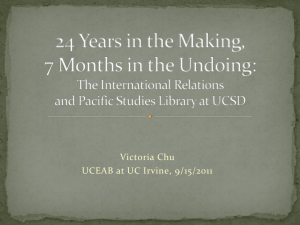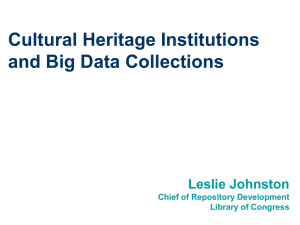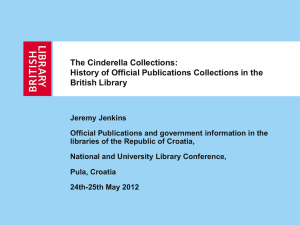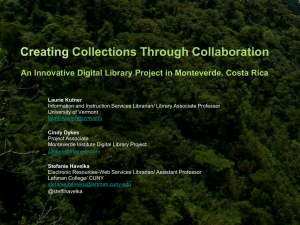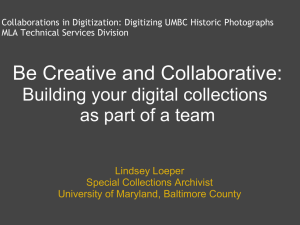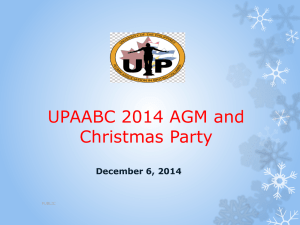ppt - Infopeople
advertisement
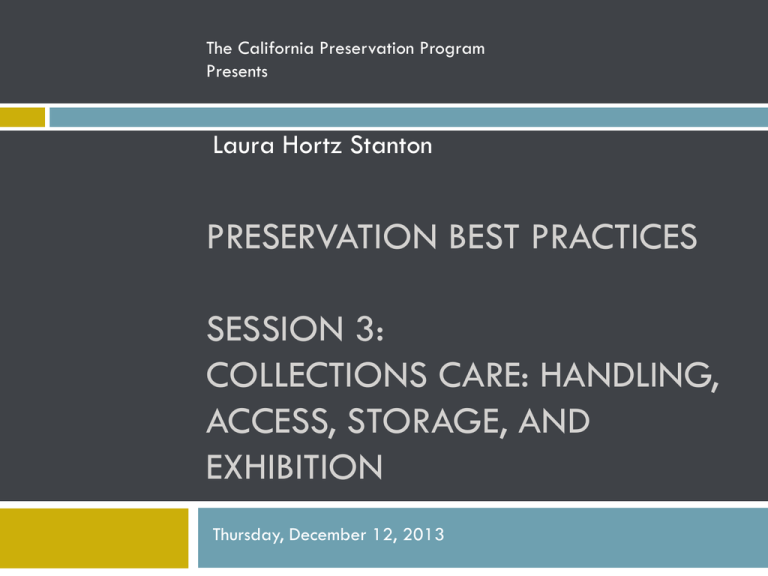
The California Preservation Program Presents Laura Hortz Stanton PRESERVATION BEST PRACTICES SESSION 3: COLLECTIONS CARE: HANDLING, ACCESS, STORAGE, AND EXHIBITION Thursday, December 12, 2013 Today Handling Access Storage Exhibition Handling and Access Poll Handling and Access: Getting Started There are written handling guidelines for both staff and researchers Handling Procedures Staff Handling Moving Carts Transportation Researchers pencils limit # items gloves with photographs lockers monitor sherwords.blogspot.com Mishandling Handling and Access: Getting Started Preparation for Handling Objects Wash hands and dry thoroughly Remove jewelry (bracelets, rings, large belt buckles, etc.) and name badges. Remove items from top pockets Handling and Access: Getting Started Gloves are available for use as necessary http://www.sharifphotographic.co.uk Handling and Access: Getting Started Carts are available to move collections throughout the building Courtesy Athenaeum of Philadelphia Handling and Access: Getting Started Landing spaces are available in collections storage spaces to aid in retrieval and return to storage Handling and Access: Getting Started Staff members are trained in appropriate handling techniques Handling and Access: Good Mounts and supports are available to staff and researchers using the collections Handling and Access: Good A system is in place for reporting and recording damage to collections materials Enclosures are marked for collections that are fragile and/or require special handling instructions Only specially trained staff move collections materials Access to fragile materials is limited until rehousing or conservation treatment can be completed Image via the Brooklyn Museum Handling and Access: Better Collections materials are in protective enclosures for transportation, handling, and research Conservators and art handlers are consulted and retained for moving large, awkward, or particularly fragile materials Archival Polyester L-Velopes, http://www.universityproducts.com Collections Storage Poll Collections Storage: Getting Started There is sufficient space to store all collections materials according to established standards Image by keightdee, www.flickr.com Collections Storage: Getting Started Shelving is in place and all collections are stored at least 3 inches off the floor Non-collections materials are not stored with collections materials Collections Storage: Getting Started Collections are housed using conservation-grade materials What does “archival” really mean? • • • Buzz words to look for: Acid-free Lignin-fee Buffered Photograph courtesy of Joan Irving, Winterthur Collections Storage: Getting Started Avoid inappropriate fasteners and adhesives Collections Storage: Getting Started Aisles are of sufficient width and are clear of collections materials Materials can easily be retrieved from shelving and necessary step stools and ladders are available http://www.archives.gov/preservation/storage/undergroundfacilities.html Collections Storage: Good Storage furniture is made from powder coated steel and accommodates collections of various sizes and shapes (rolled, oversized) There is room for collections growth Subject specialists and conservators are consulted regarding optimal storage for collections materials www.museum.spacesaver.com Collections Storage: Good Collections materials are stored by format Images from the National Film and Sound Archive, Australia Collections Storage: Good Collections housing is refined and all materials are secure within boxes/enclosures University Museum of Archeology and Anthropology Single Roll Storage Boxes, www.hollingermetaledge.com Photographs courtesy of Joan Irving, Winterthur Collections Storage: Better Collections pieces are stored on or with specialized mounts that can be used for access and/or exhibition A space plan has been conducted to ensure that the space is being used at its maximum capacity Collections Storage: Better Specialized storage environments are in place for collections materials with specialized needs Storage enclosures are regularly inspected to ensure they are still meeting the needs of the collections Image via the National Park Service Exhibition Poll Exhibition: Getting Started rowanwilliams.archbishopofcanterbury.org Materials that are fragile or in poor condition are not placed on exhibition Only conservation-grade materials are used for exhibit mounts and mounts fully support the object on exhibit Exhibition: Getting Started Food and drink are not permitted in exhibition areas and galleries are not used as special events spaces Exhibit cases are secure and are not harmful to collections materials Sensitive materials on exhibition are regularly rotated Exhibition: Good Gleeson Library at USF, www.flickr.com Materials on exhibit are regularly checked for condition during the exhibition period Advice regarding mounts and appropriate exhibition methods is sought from qualified specialists Lighting levels can be, and are, adjusted to meet the needs of specific materials Exhibition: Good Cases are designed to maintain specific environments for the collections Condition reports are completed for materials before and after exhibition L Style Standard Case with Rolling Deck www.smallcorp.com Exhibition: Better An exhibition policy is in place that outlines guidelines for length of exhibition, lighting, and mounts Exhibition Policy Selection Support Length of time on display Security Light Housekeeping Seattle University Law Library Exhibition: Better Records are kept for length of time and light levels for each collections piece placed on exhibition All collections materials to be exhibited are examined, treated (if needed) and mounted by a conservator who is part of the exhibition team Plans for what materials will be exhibited are made at least one year in advance so mounts and conservation treatment can be planned Image via Artifact Advocate Thank you and Questions Questions about collections care? Contact the California Preservation Program info@calpreservation.org Next Session Session 4: Planning and Prioritizing December 19, 2013 http://www.semwisdom.com/blog/wp-content/uploads/data-analysis-cartoon-1.gif California Preservation Program This series is sponsored by the California Preservation Program, a project of the California State Library, supported in part by the U.S. Institute of Museum and Library Services under the provisions of the Library Services and Technology Act, administered in California by the State Librarian. CalPreservation.org Helping preserve heritage collections

